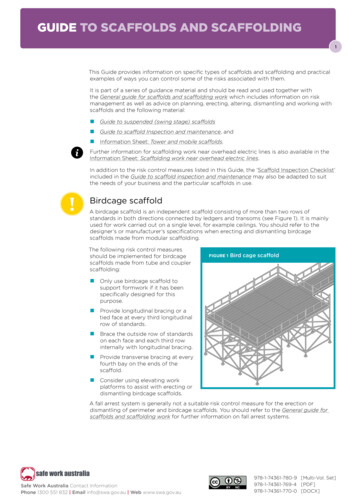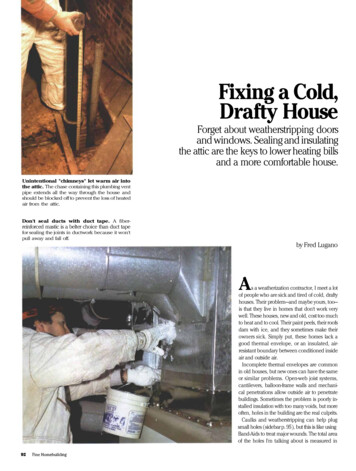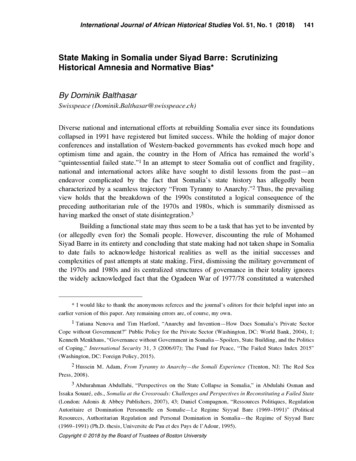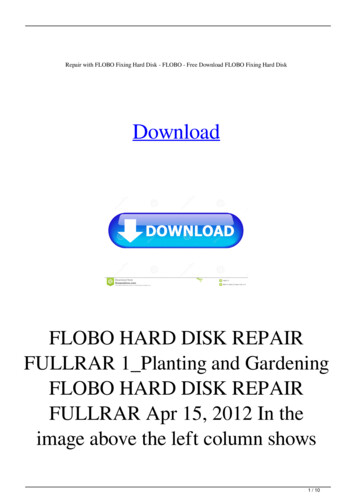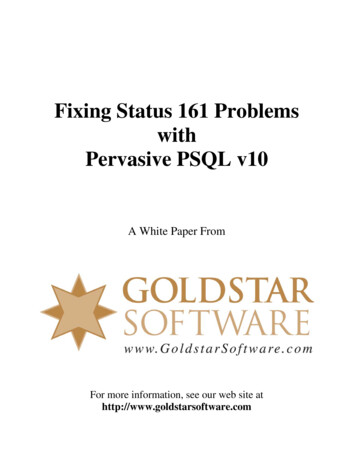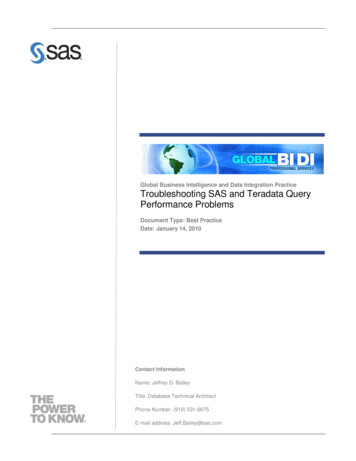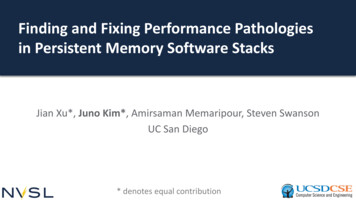
Transcription
Finding and Fixing Performance Pathologiesin Persistent Memory Software StacksJian Xu*, Juno Kim*, Amirsaman Memaripour, Steven SwansonUC San Diego* denotes equal contribution1
Persistent Memory New tier of memoryOur paper– Low latency persistence (than SSD,HDD)– Large capacity (than DRAM)Battery-backed NVDIMM Intel Optane DC Persistent Memory– First scalable persistent memory– Re-evaluated some of our results on thisdeviceThis talk2
Where are we now?ApplicationPM-awarefile systemPersistent memoryRedisSQLiteMySQLLegacy file systems- XFS-DAX- Ext4-DAXRocksDBCassandraSAP HANALMDBand more!Custom file systems- BPFS [SOSP’09]- PMFS [Eurosys’14]- NOVA [FAST’16]- Strata [SOSP’17]3
Let’s see the whole picture Let’s fix the old codes– Legacy codes built for disk run slow on PM Let’s study the new trade-offs– What are the best ways to optimize software systems on PM?– What are the trade-offs? Complexity vs. Performance? Our goal: fix urgent problems and provide best practices for optimization.4
Key questionsApplicationPM-awarefile systemPersistent memoryWhich optimizations offerthe best complexity/performance trade-offs?Are custom file systems worth it?What bottlenecks remain?5
ContributionsApplicationPM-awarefile systemPersistent memoryWhich optimizations offerAnalyzea range of optimization techniquesthebest complexity/performancetrade-offs?Are custom file systems worth it?Show why custom file system is valuableWhat bottlenecks remain?Improve scalability for PM file systems6
Candidate techniques for optimizing appsLittle to noneEasyUser spaceprogramming costVaryUse PM file systemEmulate POSIX IO in userspaceBuild PM data structureAppAppAppFile IO emulationPM data structureHardPOSIX APIKernel spacePM-aware file systemDAXDAXPersistent Memory7
FLEX : FiLe Emulation with DAX Emulate POSIX IO in userspace with DAX––––open mmap a filememcpy clflush/clwb for writememcpy for readfallocate mmap for extending file space Pros– Bypass file system overhead (e.g. journaling)– Amortize PM allocation cost by preallocation Cons– Guarantee only 8-byte sh/clwbnontemporalstore8
FLEX append examplemmap addresswrite offsetallocated ed regionallocated PM spacenon-persisted data (in lstorepersisted data9
Applying FLEX to applications RocksDB, SQLite– Use file to implement Write-Ahead Logging (WAL) for consistency Most apps do NOT rely on the parts of POSIX that FLEX sacrifices [1]– Atomicity– File descriptor aliasing semantics Therefore, no logical change is required– RocksDB 56 LOC, SQLite 233 LOC[1] Pillai et al, All File Systems Are Not Created Equal: On the Complexity of Crafting Crash-Consistent10Applications, OSDI’14
FLEX achieves substantial speedupsOn Optane DC PMRocksDB random SETSQLite random SET2 6x2 4x1.7x3.1xFLEX achieved 2 6x speedups over POSIX with simple changes.FLEX reduces the gap between three file systems11
Let’s try a harder oneLittle to noneEasyUser spaceprogramming costVaryUse PM file systemEmulate file IO in userspaceBuild PM data structureAppAppAppFile IO emulationPM data structureHardPOSIX APIKernel spacePM-aware file systemDAXDAXPersistent Memory12
PM data structures Crash-consistent– No additional logging is required Difficult to build– Complex operations (e.g. B-tree split/merge, hash table resizing)– More challenging for concurrent data structures Recent progress– LSM-tree: NoveLSM [ATC’18], SLM-DB [FAST’19]– Hash-table: Level hashing [OSDI’18], CCEH [Fast’19]– B-tree: NV-Tree [FAST’15], FP-tree [SIGMOD’16]13
Persistent skiplist in RocksDBOn Optane DC PMConcurrent skiplistLocking-based skiplist25% fasterthan FLEX20% slowerthan FLEXModified lines:56380Modified lines:5638014
Takeaway FLEX is a cost effective option for accelerating applications.– Some applications can do this easily. PM data structures can provide better performance but developersshould carefully weigh the trade-offs.15
Key questionsApplicationPM-awarefile systemPersistent memoryWhich optimizations offerAnalyzea range of optimization techniquesthebest complexity/performancetrade-offs?Are custom file systems worth it?Show why custom file system is valuableWhat bottlenecks remain?Improve scalability for PM file systems16
Why do we need another new file system? Legacy file systems already support PM access– XFS, EXT4 file systems are extended for PM à XFS-DAX, Ext4-DAX Can’t we just improve them?– If we could get good performance out of one of these, we should! Let’s try optimizing Ext4-DAX!17
Fine-grained journaling for Ext4-DAX Key overhead: block-based legacy journaling device (JBD2)– Write amplification: E.g. 4KB data append à 36KB writes to file/journal– Global journaling area à No concurrency Our solution: Journaling DAX Device (JDD)– Journals individual metadata fields à No write amplification– Pre-allocates per-CPU journaling area à Good scalability– Undo logging à Simplified commit mechanism (e.g. no checkpointing)18
JDD performance Compare with Ext4-DAX, NOVA Run four benchmarks––––Append 4KBFilebench varmailSQLite (the same before)RocksDB (the same before)1.5x gap Result– Faster than Ext4-DAX by 2.3x– NOVA is still 1.5x faster.19
Can we fill the gap further? “Disk first”– Ext4-DAX shares codebase with disk-oriented Ext4– Disruptive changes are not likely to happen– Further optimizations would make Ext4 a less-good disk-based file system. We do actually need a custom file system for PM!20
Key questionsApplicationPM-awarefile systemPersistent memoryWhich optimizations offerAnalyzea range of optimization techniquesthebest complexity/performancetrade-offs?Are custom file systems worth it?Show why custom file system is valuableWhat bottlenecks remain?Improve scalability for PM file systems21
Poor scalability by Virtual File System Bottleneck: Global inode structure, per-inode locking Solution: Per-CPU inode structure, fine-grained locking See our paper for details[1] Min et al, Understanding Manycore Scalability of File Systems, ATC’1622
Better scalability with NUMA-aware file access Enabled NUMA-aware file access in NOVA– Added simple interface for querying/setting NUMA location per file– Achieved 1.2 – 2.6x better throughput See our paper for details23
Conclusion FLEX is a cost-effective app optimization technique. PM data structures can provide better performance but developersshould carefully weigh the trade-offs. Custom file system provides better performance and legacy file systemsare unlikely to close the gap. Memory-centric optimizations (e.g. NUMA) are now applicable (andprofitable) for file.Thank you! Questions?24
MySQL Cassandra LMDB Custom file systems-BPFS [SOSP'09]-PMFS [Eurosys'14]-NOVA [FAST'16]-Strata [SOSP'17] Persistent memory Application PM-aware file system . PM data structures can provide better performance but developers should carefully weigh the trade-offs. Custom file system provides better performance and legacy file systems



